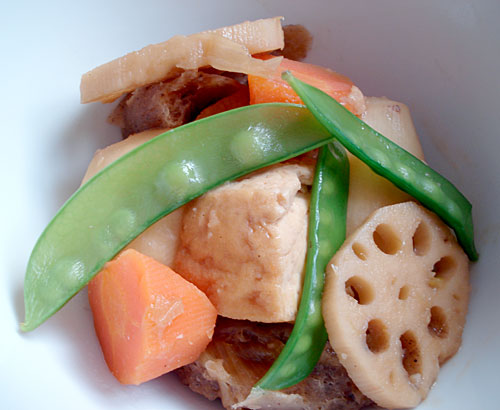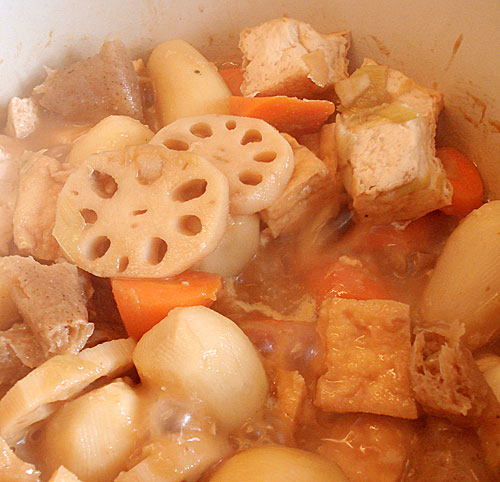Root vegetables and tofu stewed in miso sauce (a vegan one-pot meal)

(On the forum and elsewhere, I frequently hear vegans lamenting the lack of vegan protein-rich dishes. Such dishes do exist in traditional Japanese cooking, and I try to introduce them to you. Not all dishes are that simple to make, though if you read through the recipes they aren't really that hard. Anyway, here's one vegan one-pot dish that is good hot or cold, so is very suited to bentos.)
There are all kinds of stewed dishes in Japanese cooking, called something-ni (煮). Collectively these are called 煮物 - ninomo. This is sort of a vegan variation on a classic nimono called chikuzen-ni (筑前煮), which is a staple of the New Year period and the winter months.
Chikuzen-ni gets its umami from chicken pieces and a rich dashi made from konbu seaweed and lots of katsuobushi, dried bonito flakes. Here I've skipped the dashi (though you could use vegan dashi for even more flavor), but I've used one of my favorite vegan proteins, atsuage or thick fried tofu, and added a lot of umami by using shiitake mushrooms, leek, and miso to finish. There are three kinds of root vegetables in this: taro root (satoimo 里芋 in Japanese), lotus root (renkon 蓮根)and carrots, so it's full of fiber and nutrition and is a fairly complete vegan meal. I used it for a bento last week, and found it very filling. (I meant to use the leftovers for another bento round at least, but it got eaten up by someone...)
If you can't get a hold of taro roots or dislike the slightly slimy texture, substitute boiling potatoes (the kind you use for potato salad, not baking potatoes). If you can't get lotus roots, just leave them out and use more carrots.
This is not a quick recipe, but you can make a potful of it and can last you for several days of bentos and other meals.
Recipe: Root vegetables and fried tofu in miso sauce

- 1 medium lotus root (or a packet of pre-cooked lotus root slices)
- 8-10 small taro roots (you can buy prepared frozen ones in some Japanese markets)
- 2 medium carrots
- 6-8 shiitake mushrooms
- A piece of the white part of a leek about 25cm / 10 inches long
- 1 large (300g / about 10 oz) atsuage or thick fried tofu
- Vegan dashi - optional or plain water
- About 1 Tbs. vegetable oil
- 3 Tbs. white miso
- 1 Tbs. soy sauce
- Snow peas (mangetout) for garnish
Equipment suggested: A heavy bottomed pot, such as a cast iron enamelled pot
There's a lot of prep work with this. You can do the prep part a bit in advance, then put everything together. Using pre-cooked or frozen lotus root and taro roots saves you lots of time!
Peel the lotus root, cut into slices (cut in half if they are very big), and boil for about 5 minutes in water with a little vinegar added - see how to cook lotus root. Drain and set aside.
Wash and peel the taro roots. If necessary, cut the big ones in half and peel off the sharp edges, so they are all sort of round. (See more about taro roots).
Peel and roughly cut up the carrots.
Cut the stems off the shiitake; leave whole or cut into thick slices.
Blanch the fried tofu in boiling water for a couple of minutes, then drain. This gets rid of excess surface oil. Cut the tofu into chunks.
Slice the leeks roughly.
Heat up the oil in the pot, and add the leeks. Sauté until limp. Add the vegetables (except for the snow peas) and the tofu pieces and sauté briefly. Add the soy sauce and enough dashi or water to cover. When it is bubbling, put a pot lid that is smaller than the diameter of the pot you're using right on top of the food, so that it's holding everything down. (This is the otoshibuta method used a lot in Japanese cooking, explained at the end of this recipe.)
Let everything simmer, stirring up from bottom occasionally, over low-medium heat until the taro root and carrots are cooked through. (The lotus root may remain crunchy.)
Dissolve the miso in a little bit of the cooking liquid, and add to the pot. Stir well and simmer a few minutes more. Taste and see if it needs more soy sauce or salt etc.
Serve garnished with something green, such as blanched snow peas or just some chopped green onion.
Other vegetables you could use
If you have them, you could use pre-boiled bamboo shoot, burdock root (gobo), and so on instead of or in addition to the vegetables used here.
Using this for bentos
If you keep it in the refrigerator, it will last for a few days. To be absolutely safe you should heat it up briefly before cooling down again and packing into your bento.
You could freeze it, but if you substitute potatoes for the taro roots, take them out since frozen potatoes have an unpleasant mealy texture.
See also
Vegan nikujaga (stewed 'meat' and potatoes)
If you enjoyed this article, please consider supporting this site by becoming my patron via Patreon.
